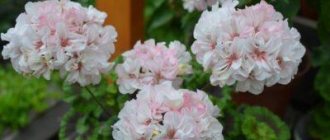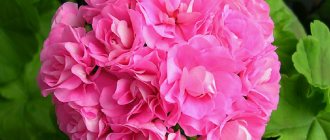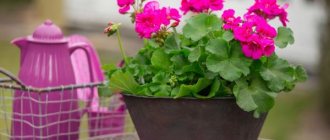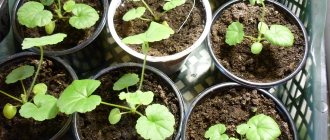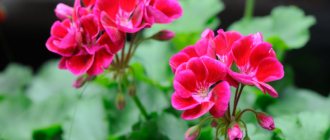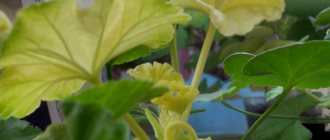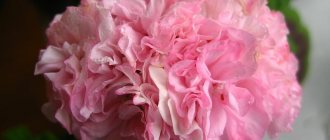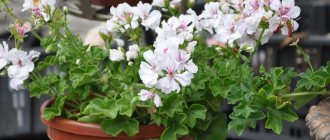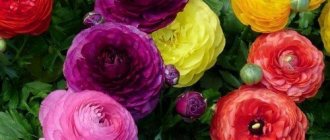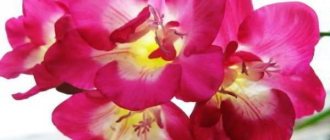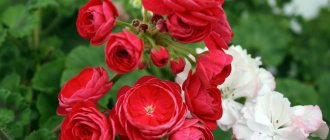Description, history and cost
As a result of the work carried out by breeders on growing hybrids, many varieties and varieties were developed, among which Pelargonium Fragrant takes a significant place. It is a herbaceous perennial or subshrub with a well-developed root system.
There are several types of stems:
- creeping;
- branched;
- straight.
The foliage is palmate-lobed, rich green. The top is covered with small villi. If you touch these fibers, you can feel a light aroma reminiscent of lemon, pine needles, ginger, peach, mint, and nutmeg. There are about 150 pelargonium scents.
On a note. Fragrant pelargonium is widespread. You can buy it at a flower shop at a reasonable price. One bush will cost about 250 rubles. The cost almost always stays at this level.
Other popular varieties of pelargonium from the Odensjo series
Pelargonium PAC Viva Madeleine, Carolina and other varieties
Symphony pelargonium has a number of varietal representatives, among which you can choose a plant based on color and type of flowering. The most popular varieties:
- Sound of Silence. Pelargonium Odencio species Sound Silence grows slowly, the bush is compact, and the flowers are distinguished by a delicate white color with a greenish tint. The crop should be watered carefully because it has a small root system.
- Suzie Wong. Susie Wong differs from the Odencio standard in the deeper and richer pink color of the double petals.
- Rodluvan. It has bright red flowers, bushes well, and does not require frequent pruning. The variety is characterized by voluminous inflorescences, which makes it luxurious.
- Bernadette. One of the most delicate flowers of light pink pastel. The plant belongs to the dwarf species.
- Hummingbirds Egg Butterfly. The subspecies with an intricate name attracts attention with its rich lilac-pink color. Large flowers contrast with variegated green leaves.
- Ice Frozen Campari. Zonal pelargonium stands out with lilac flowers, which complement the bright inclusions on the petals and the core.
- Lynn Palmer. The flower is suitable for growing in pots. Petals are semi-double with a color gradient from white to purple and green.
- Madame Bovary. Bovary attracts attention with its expressively bright red color. Inflorescences are collected in large bouquets.
- Stilla Flirt. The smallest and most elegant variety from Odensio. The soft pink color is reminiscent of the gold standard of this type of pelargonium.
Pelargonium Bernadette perfectly reveals and complements the main view
Appearance and features
The stem has many branches. Its base is lignified. It reaches a height of about 1 meter. The upper leaves are arranged alternately, the lower leaves opposite each other. The color varies - from light green to dark marsh. Splashes of red and burgundy dilute the monotony. There is a frill or deep cut along the edges of the foliage. The flowers are small, odorless, collected in umbrella-shaped inflorescences. Various shades:
- violet;
- pink;
- white;
- yellow.
Doesn't bloom often.
Varieties of fragrant pelargoniums
- Felt pelargonium P. tomentosum Chocolate Mint (syn. Chocolate Peppermint ) - low-growing, up to 30 cm tall, with slightly hanging shoots. The leaves are medium to large, deeply lobed, soft, velvety, with a chocolate brown spot in the center, and smell of mint. The flowers are pale pink, with purple feathers on the upper petals.
- Pelargonium capitatum P. capitatum Attar of Roses - up to 45 cm tall, with large trilobed leaves that have a strong rose aroma. The flowers are lilac-pink, with a burgundy throat.
|
|
- Pelargonium curly P. crispum Cy's Sunburst - has small lemon-scented corrugated variegated foliage - green with a thin golden border. The flowers are pink.
|
- Pelargonium P. quercifolium Giant Oak - with very large, lobed leaves with a balsamic scent.
- Pelargonium pink P. radens Red-Flowered Rose is an openwork pelargonium with grayish-green palmate foliage (for which it is called Crow's Feet) and abundant red-pink (brighter than the main species) flowers. Very drought resistant.
|
|
- Pink pelargonium P. radens Radula - leaves are less finely cut than those of the main species (P. radens), with a less bright aroma. The flowers are small, lilac-pink.
Photo
Below you can see a photo of the plant.
Medicinal properties
The flower has many useful qualities. The leaves of fragrant pelargonium contain:
- Essential oils.
- Organic acids.
- Starch.
- Copper.
- Tannins.
- Calcium.
- Pectins.
- Glycosides.
It is known that the plant is able to normalize the nervous system. In the house where this pet is located, domestic quarrels do not arise so often. If fragrant pelargonium is in the office, then a person is guaranteed to feel cheerful.
The leaves have the following properties:
- Bactericidal.
- Painkillers.
- Absorbable.
- Softening.
They can also help with swelling, headaches, runny nose, restore blood, and accelerate wound healing. The juice collected from the leaves is used in the treatment of otitis media.
Pelargonium oil can treat hypertension, diabetes, infertility, and painful periods. You just need to add a couple of drops to the aromatic llama's bowl and light the candle. Another option is to mix 7-8 grams of plant oil and 30 grams of base and perform a massage.
Insects do not like the scents of pelargonium and are afraid to fly into the room where it is located . This effect is achieved due to its insecticidal properties. There are known cases where a decoction of the leaves treated pediculosis. If you put branches in a closet with clothes, you can forget about the appearance of moths forever.
Despite the many medicinal properties, there are a number of contraindications for the use of drugs made from this plant:
- Low pressure.
- Stomach ulcer.
- Pregnancy.
- Gastritis.
Graveolens Group
Varieties of aromatic pelargonium (P. graveolens).
- Camphor Rose is an upright growing plant, up to 45 cm tall, with deeply cut leaves with a strong aroma of camphor and mint. The flowers are purple-pink.
- Lady Plymouth is a very popular variety, 45-60 cm tall, thin white petaled leaves with a eucalyptus scent. Inflorescences of lavender-pink flowers appear in summer.
|
|
- Both's Snowflake is an upright grower, 30-60cm tall and wide, with deeply cut leaves sparkling with irregular creamy variegation, and scented with rose.
|
- Variegata - up to 60 cm, with pink flowers and variegated white-green leaves with the aroma of mint and rose.
Where and how to plant?
Fragrant pelargonium is completely unpretentious. She is patient with unfavorable conditions, but this should not be abused, because she also has preferences. Grown from cuttings or seeds.
- Lighting and location. It is recommended to place the pet on a windowsill with windows facing east or west. There the growth will be much faster and the flowering will be more magnificent. When located on the south side, it is necessary to take into account that constant exposure to direct sunlight is not desirable, so you will have to shade it.
- Soil requirements. To prevent root rotting, a drainage layer is placed at the bottom of the pot.
Expanded clay and broken bricks are suitable for drainage. It is already allowed to place a flower with a lump of earth on top. The last layer is a soil mixture for indoor flowers. To prepare the substrate you need to take 1 part of peat, humus, turf and sand. Important! This mixture is calcined in the oven.
Fragrans Group
Varieties of fragrant pelargonium (Pelargonium fragrans).
|
|
- Fragrans Variegatum is a subshrub up to 15 cm tall, often with reddish stems, leaves are velvety, three-lobed, blunt-toothed along the edge, light green, with a chartreuse-colored edge, with a spicy aroma. The flowers are white, collected in inflorescences of 4-8, the two upper petals with small red stripes.
- Lilian Pottinger - 25-30 cm tall and 12-16 cm wide, leaves are gray-green, irregularly three-lobed, serrated along the edges, with a complex aroma of camphor and pine. Produces masses of white flowers in summer with small red markings on the upper petals.
- Ardwick Cinnamon – has small, velvety, cinnamon-scented, dull green foliage and white flowers with crimson markings on the upper petals.
|
|
Home care
- Temperature conditions. Fragrant pelargonium does not like excessive heat. The optimal air temperature is +20 degrees. It is necessary to ventilate the room, as this has a beneficial effect on the flower. In summer, the plant is often taken out onto an open balcony.
- Watering is done after the top layer of soil dries. Does not require spraying. Watering should be moderate. Does not tolerate stagnant water. The main feature of pelargonium is the ability to accumulate moisture in the leaves and stems.
- Pot. If the container is large, then all energy is spent on the development of roots, the flower grows slowly, a small number of shoots is observed, and there is practically no flowering. Based on this, we can conclude that the container is selected only a couple of centimeters wider than the root ball.
- Fertilizers. The use of fresh organic matter is prohibited. Complex additives that contain nitrogen, potassium, and phosphorus are ideal. Fertilizers are applied every 14 days from early March until October. In winter there is no need to fertilize. It is worth refraining from feeding if the pet has recently been transplanted.
- Pinching and trimming. To prevent stretching, to give the bush a neat shape, to increase the number of shoots, old stems are pinched. Formation should begin from the first days of cultivation. The main goal is to achieve branching.
Diseases and pests
Blackleg. The stem turns black near the base, then the disease spreads over the entire area of the plant. The disease cannot be cured. The disease can only be avoided by observing safety measures at the time of purchase and the process of planting and transplanting.- Gray rot. A gray coating appears on the leaf plate, a clear sign of rot. To save, you will need to completely stop watering, remove the affected areas, and treat with a fungicidal solution.
- Whitefly and aphids. Pests hide on the inside of the leaf and feed on pelargonium juice. A sign of their defeat is yellowing and falling leaves. To get rid of insects, you need to wash with soapy water and treat with insecticides a couple of times.
Diseases and pests, combating them
The flower is quite resistant to diseases and is not capricious. The most common reasons for the poor state of culture:
- improper watering or air humidity;
- virus infection;
- attacks by mites, aphids and caterpillars;
- bacterial infections.
The main way to prevent problems is timely care and maintenance, and treatment is carried out by carefully removing diseased leaves. New shoots will appear in their place.
Odensjo Symfonia pelargonium is distinguished not only by its amazing flowers that can delight almost the whole year, but also by its original aroma. This unpretentious and at the same time beautiful flower was a favorite of aristocrats in the 18th century.
Features of reproduction
There are 2 types of propagation - using seeds and cuttings. The first method is considered more complex, but its main advantages: compactness of the bush, abundant flowering.
Seeds
- First, the grains are peeled from the outer shell.
- Then they are treated with epin and soaked in water for 3-4 hours.
- Seeds are sown at a distance of 5 centimeters from each other.
- After they have been placed in the ground, they are sprinkled with a 5-6 mm layer of earth on top, watered and covered with glass.
- The first shoots will appear after 2 weeks.
- Ultimately, picking and seating occurs in separate containers.
Cuttings
- A shoot with several leaves is cut off from the upper part of the pelargonium.
- Then the cuttings are placed in water.
- The roots form in a couple of days and the flower is ready for planting.
- It is necessary to maintain optimal moisture and prevent direct sunlight from penetrating.
Fragrant pelargonium is a wonderful decoration for the home. It creates a certain comfortable atmosphere that encourages a person to relax. It is very easy to care for. Even a novice gardener can handle it.
Pelargonium is one of the most common flowers on our windowsills and gardens. Read our materials about such varieties as: Pink, Lady Gertrude, Anita, Red Pandora, Rococo, tulip-shaped, Denise, April Snow, Ludwigsburg Flyer and ivy.
